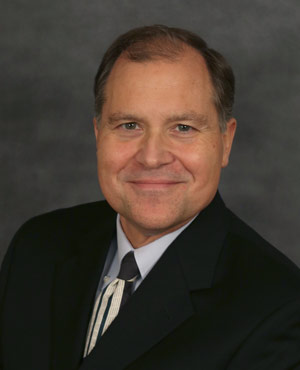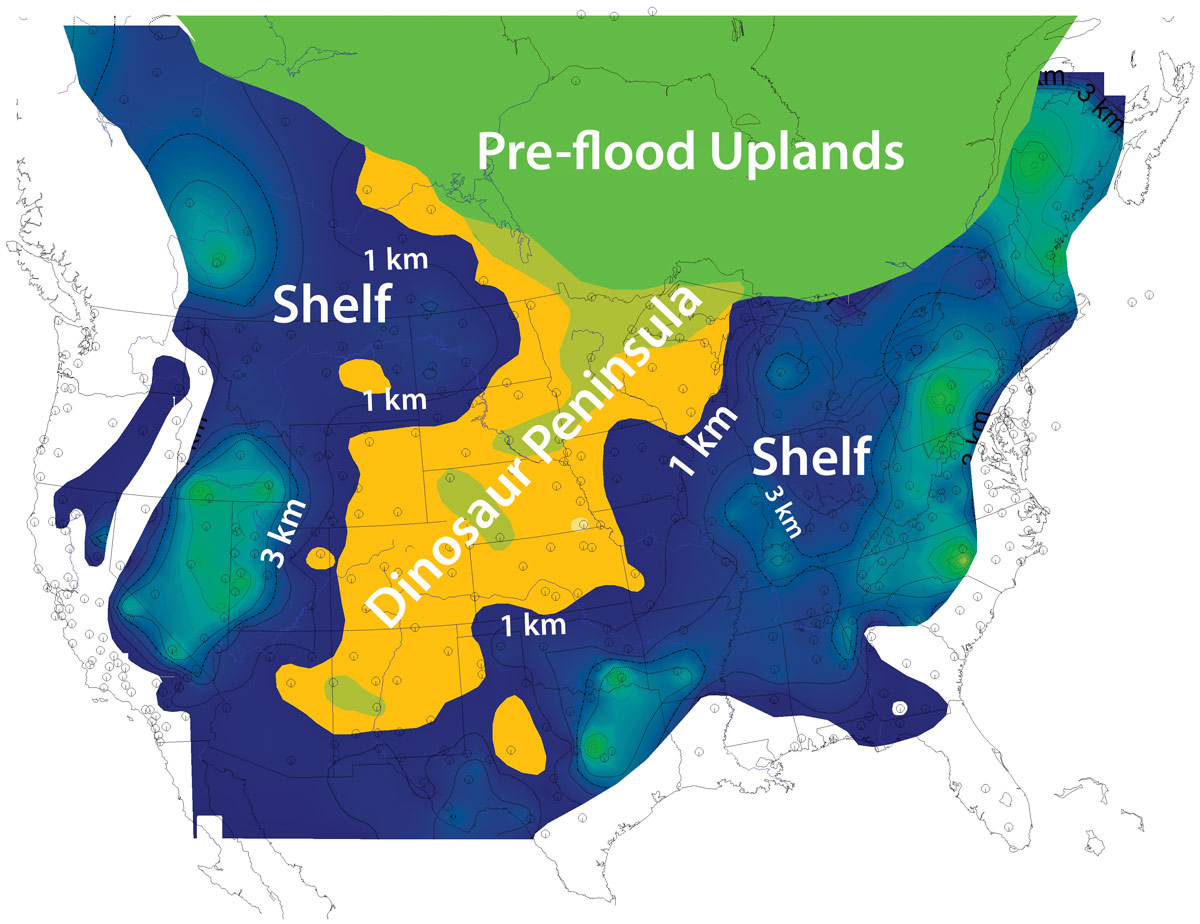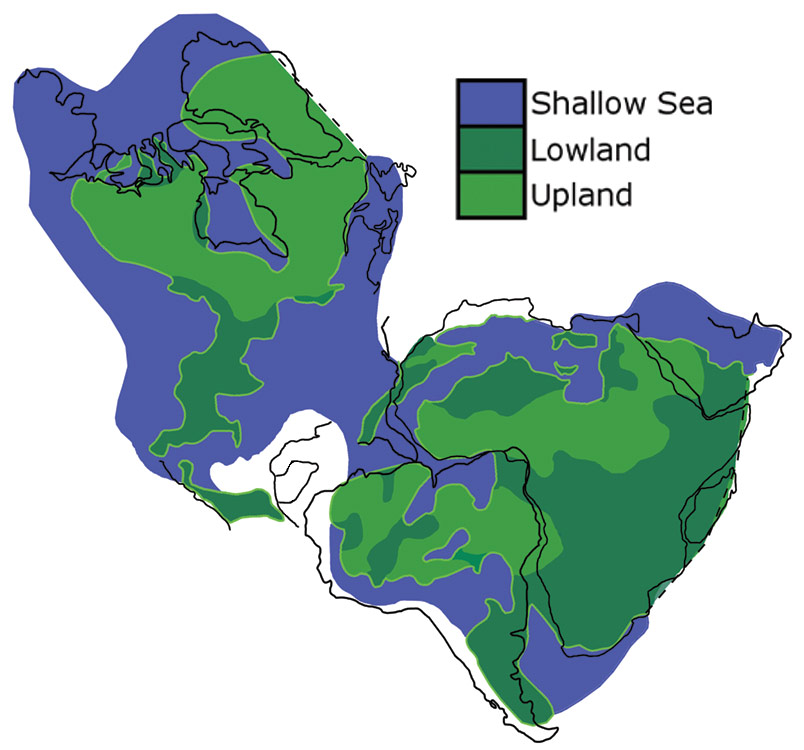How the rocks fit the Flood
Shaun Doyle talks to Tim Clarey about his research career in Flood geology.

Geologist Dr Timothy Clarey is a Research Associate and Geologist at the Institute for Creation Research (ICR) in Dallas, Texas. He earned a B.S. in geology summa cum laude, an M.S. in geology from the University of Wyoming, and an M.S. in hydrogeology and a Ph.D. in geology (1996) from Western Michigan University. Spending nearly 10 years in the oil exploration industry and 17 years in academia gave Tim a unique perspective for his work at ICR, where he now researches how the rock record fits the context of Noah’s Flood. He and his wife Renee have four grown children and four grandchildren.
Tim’s interest in rocks started early in life. As he and his brothers hoed beans for money as kids, they would compete for the best fossils they could find in the rocks in the bean fields. Most were brachiopods, with an occasional trilobite; the rocks containing them had been transported by the continental glaciers to the Lower Peninsula of Michigan where they lived. That rock collecting and sibling rivalry got Tim interested in geology.
In his words, Tim “grew up in church”. He dates making a personal decision to follow Jesus Christ at almost eight, at his home church’s Vacation Bible School. He has remained an active believer all through his life, including during his studies.
His interest in biblical creation also arose in the home. One of his older brothers had a copy of the creationist classic The Genesis Flood by John Whitcomb and Henry Morris (1961), and the brothers would take turns reading it. Tim noted: “The Genesis Flood really helped us learn about the evidence that backed the Bible and Flood geology.”

Another influence occurred during his years as an undergraduate student. A talk given by creationist pioneer Dr Duane Gish convinced him that the fossils really don’t support evolution. He later weighed what he was learning in his university classes against Dr Gish’s work and the evidence. Tim saw further confirmation that the Bible was right: the rocks and fossils are consistent with the Bible, and do not reflect evolution and deep time.
Preparing for creation research


Tim spent over 25 years in industry and academia as a geologist, which did have its challenges:
I kept fairly quiet in the oil and gas industry, at least until I got to know my co-workers better. Occasionally, I would gently debate evolution and the age of the earth with a few geologists I worked closely with. First, though, I let them see I was a competent oil geologist. Once I had their respect, I would bring up evidence for a young Earth.
Teaching in a secular college presented similar challenges: “I had to watch closely what I said in my lectures.” Nonetheless, he could still lecture on the problems with radioisotope dates and the assumptions on which the vast ages are based. He also spoke plainly about the fossil record.
I would show students that the fossils do not support large-scale evolution; they merely show sudden appearance and then stasis (staying the same)—and then disappearance. I pointed out the lack of transitional fossils between the different kinds.
He shared a heartwarming story of spiritual impact, despite the restrictions on being open about his commitment to biblical creation:
A former student relayed to me that, while he was a Christian at the time, the young lady next to him in my class was not. He told me that he appreciated the way I presented the truth of the fossil record, but he didn’t know how it was impacting the young lady next to him. In essence, he told me that because of those lectures this young lady started going back to church, and accepted Christ as her Saviour a few months later. Praise God! I had no idea that God was using my lectures to make such an impact, even though I couldn’t talk about God or creation.
Mapping the rock record and the pre-Flood world
Tim joined ICR as a full-time geologist in 2013. His first major (and current) research project is called the Column Project. Tim explains:
It entails plotting stratigraphic columns from oil well, outcrop, and even seismic data into a database, continent by continent. Basically, I’m plotting the actual rocks that are in place all over the globe. So far, I have three continents completed and another nearly finished. All the continents show the same sedimentation patterns that reflect a single watery catastrophe. They all begin with minimal sedimentary coverage and rock volume, and reach a peak in coverage and volume on all continents at the same time. The results are showing the true global nature of the Flood.

His completed work so far has meant compiling data from over 1,500 stratigraphic columns across North and South America, Africa, and the Middle East.1
From the geologic data recorded in these columns Tim has worked to map the pre-Flood geography. He has found that the depositional patterns and arrangement of fossils help reveal where the coastlines likely may have been in the pre-Flood world. These also indicate that different ecological zones were separated roughly by elevation.2
Tim has also incorporated Dr John Baumgardner’s Catastrophic Plate Tectonics into his model. He says it provides a more comprehensive understanding of sedimentation patterns, tectonic movement, and fossil ordering during the Flood.3
Tim has felt a sense of purpose and guidance throughout his career, leading him to the creation research he is doing now:
I see God’s hand in my career path every step of the way, in amazing fashion. First, my time in the oil and gas industry allowed me to learn about oil-well and seismic data, sequence stratigraphy, and the geology of the continental USA. I use those skills now in the Column Project. Even getting laid off from the oil industry ‘forced’ me to get a Ph.D. Without that and the research skills that come along with it, I don’t think I would have been able to conduct my current research as effectively.
Standing firm on the Bible
Although Tim’s work deals with rocks and fossils, it is significant for affirming the trustworthiness of the Bible and the integrity of the Gospel. Tim explains:
The truth of God’s Word is on the line, and ultimately, salvation is on the line. The Bible makes it clear that God created everything in six literal days some 6,000 years ago. He put the genealogies in the Bible for a reason. We must believe He did what He said. Sadly, evolution and long-age thinking are turning people away from God. We need to show people that they can trust God and His written Word.
If God’s Word is shown to be untrue or even partially untrue, it would undermine Jesus’ credibility. If the parts of the Bible that says certain events happened when they really didn’t—are merely stories—then who’s to say whether other parts of the Bible, like the crucifixion and resurrection of Christ, aren’t just stories, too? We have to believe all of God’s Word, from the very first word to the last. And the biggest problem most people have in doing that is with the book of Genesis and its accounts of creation and the global Flood.
Tim says these are exciting times for creation geology! He thinks it is fascinating to see where the research is leading. He says, “There are so many things we now know and can do that we didn’t know and couldn’t do even five years ago. New research has given us new and better ways to see the Flood in the rocks and fossils.” He points out that seeing this research blossom is incredibly faith-affirming:
I’m excited that my research is showing people the global Flood as described in the Bible really happened, and that the evidence, correctly interpreted, shows how the water rose and covered the entire planet. That’s why I am so passionate about it. God’s Word is truly true! And Jesus is the Way, the Truth and the Life. Believing and accepting the truth of Jesus’ sacrifice and His shed blood is what salvation is all about. I am just thankful that God is able to use me in this way.
References and notes
- Clarey, T.L. and Werner, D.J., Global stratigraphy and the fossil record validate a Flood origin for the geologic column; in: Whitmore, J.H. (Ed.), Proc. Eighth Int. Conf. Creationism, Creation Science Fellowship, Pittsburgh, Pennsylvania, pp. 327–350, 2018; creationicc.org. Return to text.
- Clarey, T.L. and Werner, D.J., Use of sedimentary megasequences to re-create pre-Flood geography; in: Whitmore, Ref. 1, pp. 351–372, 2018; creationicc.org. Return to text.
- Clarey, T.L., Empirical data support seafloor spreading and catastrophic plate tectonics, J. Creation 30(1):76–82, 2016; creation.com/cpt . Return to text.







Readers’ comments
Comments are automatically closed 14 days after publication.